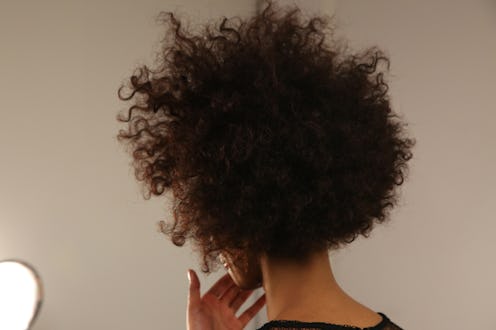(Hair)
You Can Microneedle Your Way To Thicker Hair Now, Too
For anyone dealing with hair loss, this at-home treatment is essential.

Derma rollers outfitted with hundreds of teeny, tiny needles have officially taken the skin care industry by storm. At home microneedling has become a go-to technique for anyone dealing with acne scars, dullness, and even fine lines — the theory being that “wounding” the skin with 0.5 millimeter needles stimulates a healing response and kick starts the production of collagen, which leads to plumper, more radiant skin. But it turns out, it’s not just your face that can benefit from this practice: Your scalp can reap the rewards, too. Consider microneedling for hair loss the genius new way to give your head and hair the royal treatment.
“Just like the skin on our face, the scalp also loses collagen as we age, resulting in slow hair growth and dormant hair follicles,” Natasha Jay, the founder of Pump Haircare, tells TZR. Dermatologists agree: 75% to 80% of skin is made up of collagen, Dr. Joshua Zeichner of Zeichner Dermatology in New York City tells TZR — and that includes the skin on your scalp. So while collagen is most well-known as the protein that helps keep your face firm and young-looking, it's also essential for hair health.
In fact, both collagen and hair follicles exist within the same layer of the skin — the dermis — and when collagen production slows down (around age 30, according to Dr. Zeichner), this can affect the strength of your hair follicles. “Think of it like the frame of your mattress,” the dermatologist says. “Without it, the mattress would be clumpy and wrinkly.” This leaves hair follicles unsupported, leading to more hair loss and less new growth.
Luckily, microneedling is a fairly easy way to rev up your natural production of the protein. “Microneedles lead to tiny insults in the dermis, or micro-injuries causing minor inflammation,” Dr. Melissa Doft, a plastic surgeon based in New York City, said in a press release about her in-office microneedling treatments. “This prompts the skin to stimulate collagen production in response.”
“It also brings blood flow and nutrients to the scalp and induces new stem cells that support hair growth,” Jay adds. Scientific studies have proven this to be true. In a 2018 study on the effects of microneedling on patients with mild to moderate alopecia, “Hair growth started after the first session. The patients' satisfaction was more than 75% in 18 patients, on patients' subjective hair growth assessment scale.”
If you’re already a pro with at-home derma rolling, you can apply pretty much the same facial technique to your scalp. “Wet the hair down first to create a flat surface, and start by rolling in one direction first to avoid getting hair caught in the roller,” Jay tells TZR. “Once you feel confident, you can roll in the opposite direction also, applying only light pressure.” She recommends microneedling your scalp just once a week for the first month, then twice a week in the second month. After two months, once-monthly treatments are all you need for upkeep. “This allows for the the healing process to complete most effectively,” the hair expert says.
For best results, you may want to invest in a hair-specific derma roller. Most microneedling devices for the face feature smaller needles (between 0.2 mm - 0.5 mm), but the scalp can handle a bit of a longer point. A 1.5 mm needle is standard for scalp rolling, since this size can better penetrate through hair and scalp buildup.
“Infection is a risk if you do not clean the roller after each use,” Jay warns. “Do this by applying rubbing alcohol to the roller and allowing it to dry before putting it back in its case.” Those with seborrheic dermatitis (a type of dandruff), psoriasis of the scalp, or other scalp conditions should consult a dermatologist before derma rolling. And obviously, it’s not a good idea to share a derma roller with anyone else.
The area may sting a little or turn red post-needling, which is normal — take the opportunity to slather your scalp in a calming serum or oil. “Microneedling causes small cracks in the skin’s natural barrier, which can improve the delivery of antioxidants, peptides, and other nutrients,” Dr. Doft explained on her site. In other words, derma rolling preps the skin to reap the full rewards of your regular scalp care routine. (Just stay away from potentially irritating substances, like apple cider vinegar rinses or exfoliating scrubs, for a few days.)
Shop Hair Microneedling Essentials
We only include products that have been independently selected by TZR's editorial team. However, we may receive a portion of sales if you purchase a product through a link in this article.
This article was originally published on